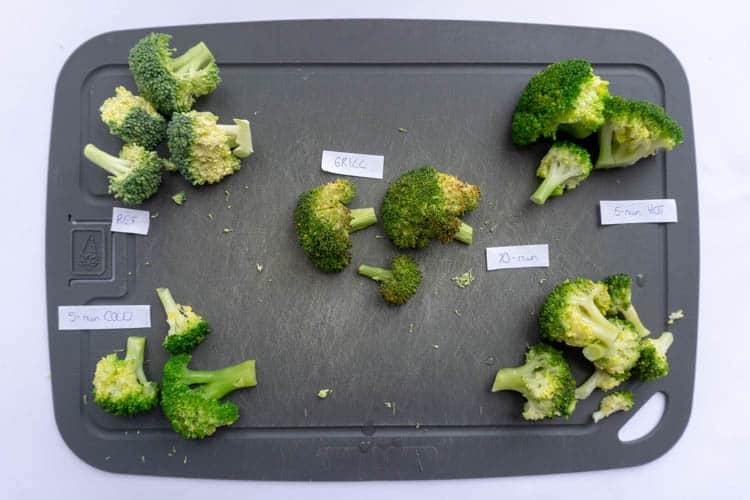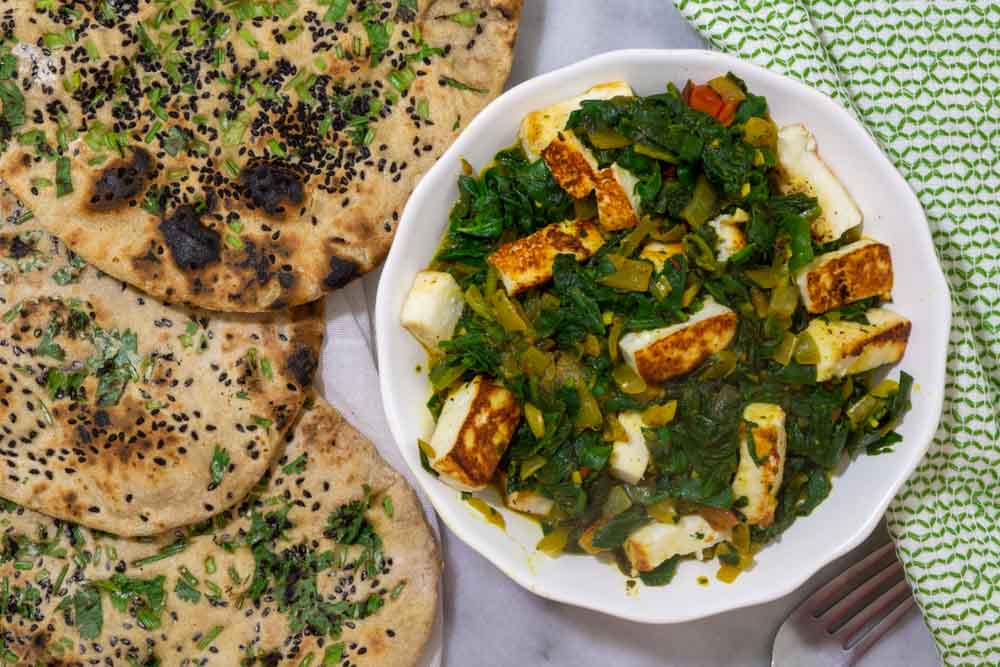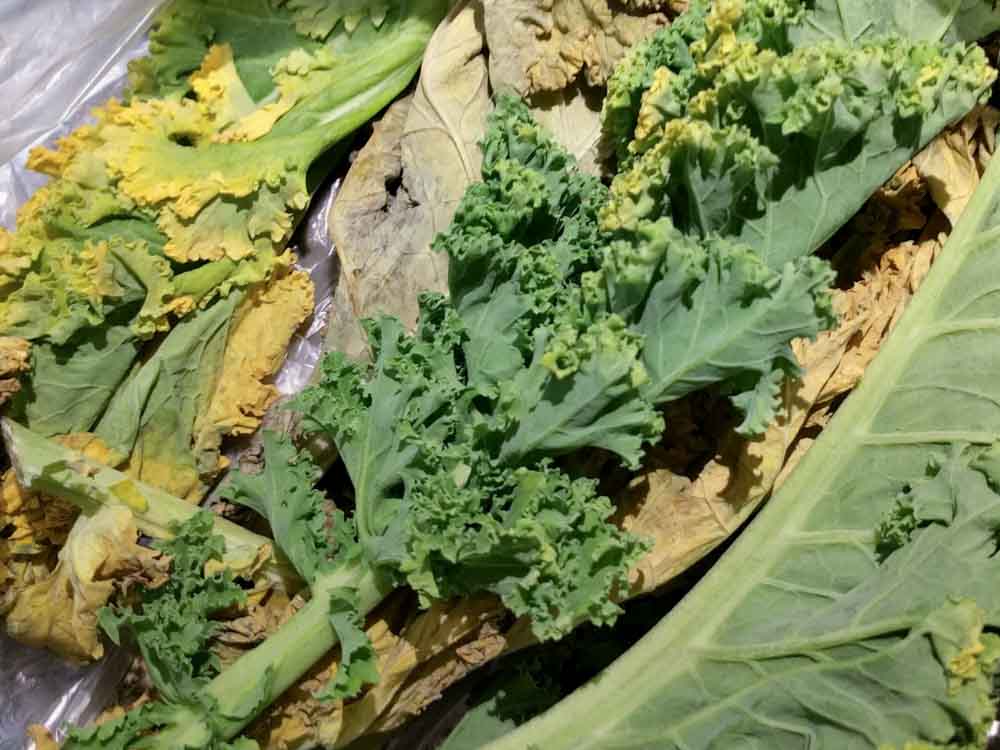Learn the science behind:

How to Keep Green Food Green – Controlling Chlorophyll
Did your salad leaves turn yellow in the fridge? Did your green beans lose their bright green color while cooking? Or did you end up with some very pale cooked broccoli?
Most natural colors, including green, aren’t very stable and are easy to lose. Luckily, once you get to know chlorophyll – the molecule responsible for most greens in food – you’ll learn there are some things you can do to keep it shining!
Chlorophyll makes the world green
Green is one of the most prominent colors in nature. Leaves, stalks, grasses, they’re all green. And, for a good reason. The green color is crucial for their survival. It’s what allows them to ‘produce’ energy.
Plants produce energy through photosynthesis
Plants can use sunlight to convert carbon dioxide (CO2) and water (H2O) into glucose, an energy source. They do this through a process called photosynthesis. A crucial first step of this process is to capture the energy of light.
This is where the green color comes in.
Chlorophyll captures light
A group of molecules called chlorophyll absorb just the right amount and type of light to power the photosynthesis process. Since they absorb and reflect certain types of light, chlorophyll doesn’t just power photosynthesis. It also colors our food green.
Some molecules can capture and reflect light. Their chemical structures are made in such a way that they interact with the light that falls on them. These are the molecules that color your food. Whether it’s the anthocyanins in red cabbage, or the lycopene in tomatoes, or the chlorophyll in pistachios.
Absorbing & reflecting wavelengths
Remember that the visible light and all the colors we see are actually waves. We see colors though, no waves. This is because our brains translate these waves into colors and light. The wavelength of a wave of light that enters our eye determines the color we see.
Sunlight is made up of light of all different wavelengths. It contains waves that are blue, green, orange, yellow, etc. Only when these waves are separated can we see the individual colors.
For photosynthesis, plants need light of a specific wavelength. Chlorophyll molecules ‘capture’ this light. The wavelengths that they can’t absorb are (partially) reflected again. We only see these wavelengths with our eye, and these waves happen to be the ones that we see as green.
Two types of chlorophyll
There are several types of chlorophyll, though they all have a very similar structure. Plants can contain two types: chlorophyll a and chlorophyll b. The other types can only be found in bacteria and algae.
The two types of chlorophyll differ a little in structure (see below). This causes them to reflect light slightly differently, and as a result, they differ a little in color. Different plants have different ratios of these types of chlorophyll, enabling a wide range of green tones.


How chlorophyll changes color
Chlorophyll molecules aren’t very stable molecules. They can break down or change configuration quite easily. Slight changes to the chlorophyll molecule can result in changes of its color. Acidity, heat, and damage can also impact chlorophyll molecules, and thus the color of your green food.
Let’s have a look at a range of different scenarios.
The changes that happen to chlorophyll show a lot of similarities to those that occur in myoglobin, the molecule that gives meat its color.

Why pickles lose their bright green color
Notice how chlorophyll contains a magnesium ion (Mg++) within its ring-like structure? This magnesium ion is not bound very tightly.
When you pickle green food, such as cucumbers, you submerge them in an acidic liquid. In an acidic liquid, there are a lot of protons (H+). These protons can take magnesium’s spot, replacing it. Chlorophyll transforms into a molecule called pheophytin.
As a result, pheophytin absorbs and reflects light differently than chlorophyll. Instead of vibrant green, it is a dull green color.

Why blanching brightens the green color
During blanching, you quickly submerge a fruit or vegetable in hot, boiling water. You take it out rather quickly, immediately cooling it. When you blanch green vegetables you may notice that they become even brighter in color. The same is true when you start cooking vegetables. That initial heat seems to pop up the freen.
Surprisingly little research has been done as to why this is the case. But it is clear that the increased brightness is not due to an increase in the amount of chlorophyll. If anything chlorophyll only breaks down because of heat.
Air bubbles ‘hide’ the green
Instead, it seems to be due to chlorophyll just shining through better. Harold McGee (which most other sources refer to) says it’s due to the redistribution of gases in the vegetables. The heat might allow these to escape.
It’s a similar effect to whipping up colored royal icing. A bright red icing can turn a pale pink simply by adding in air bubbles. The air bubbles reflect light differently. It seems as if the same is true for blanching green vegetables.
Inactivating enzymes
Another way in which chlorophyll can break down is because of enzymes that catalyze undesirable chemical reactions. Enzymes are very sensitive to heat though. A quick hot heat treatment can inactivate these enzymes, closing of this breakdown pathway.
Blanching isn’t just done to help brighten green colors. It also inactivates a range of other enzymes, such as though crucial for enzymatic browning. This way, blanched vegetables can’t turn brown as easily either which is a great benefit when freezing vegetables.

Why (extended) cooking breaks down green colors
Even though green vegetables may suddenly turn very green when added to hot water, they will lose that color again if you leave them in for longer. Chlorophyll is very sensitive to heat so will start to break down quite quickly.
The breakdown is aided by acids. Remember how the acids in a pickling liquid turn pickles a dull green color? The same is true for hot acidic water. The combination of hot + acids makes this even faster.
Most water is by nature slightly acidic, so will speed up this reaction. But, plants themselves are slightly acidic by nature as well. Once the heat starts to break down the plant’s cells, acids are released into the water. These can speed up the reaction even more.
Leaching out
But vegetables don’t just turn dull green. They can also become noticeably paler and lose their green color.
Notice how the chlorophyll molecule consists of a head and a tail? It is possible for these to break apart. If so, the head especially can leak out of the vegetables very easily, causing the color to disappear.
Why some vegetables lose their color more quickly than others
Recall how there are two types of chlorophyll in plants, a and b? Different species contain different ratios of these two types of chlorophyll. These two types differ in their stability and heat sensitivity. Chlorophyll a is more sensitive to heat than b. So, a green vegetables that contains more of type a, might be a little more stable with regards to color than one with mostly type b.
That said, it’s not just about the type of chlorophyll. The overall structure of the product also plays a role, as well as it acidity for instance.
Why lettuce turns yellow in the fridge
If you’ve stored lettuce in your fridge for some time, you may have noticed that it will turn yellow over time. The same applies to broccoli and kale. Over time, they lose their green color.
This loss of green is due to the breakdown of chlorophyll. Once harvested plants continue to respire, but degradation sets in. The presence of oxygen, light, and breakdown of cells over time all impact the degradation that occurs.
One of many processes that occurs is loss of chlorophyll. Some of it may be broken down by enzymes. Or chlorophyll is affected by acids that are released from within the plant. Jet again another possible mechanism is the breakdown of the ring structure of the chlorophyll. Once that is broken down, chlorophyll loses its color. Just exactly how chlorophyll breaks down isn’t fully understood, and differs per type of produce.
Why yellow?
But then why do these vegetables turn yellow and not white for instance? Well, most vegetables do contain other color molecules such as carotenoids. If these are more stable than chlorophyll they will become visible once the chlorophyll has broken down.
How to keep green food green
Now that you know how chlorophyll works, let’s look at how we can apply that newly gained knowledge!
Keep in mind that these tips only work for foods colored green by chlorophyll, which are almost all naturally green foods. Artificial colors work very differently and so do natural colors that aren’t based on chlorophyll.
Keep it short and hot
If you want to heat your green food, keep it hot and short. High heats inactivate enzymes that can speed up the degradation of chlorophyll. And, by keeping it short, you limit the time that chlorophyll has to break down. Even if you start hot, it will break down over time if you let it.


Keep it alkaline
An acidic environment speeds up the breakdown of chlorophyll. The opposite of acidic, an alkaline environment, slows it down. A common ingredient that can make a liquid alkaline is baking soda.
Do keep in mind though that baking soda can break down the structure of cells more quickly. You could end up with a nice green, but mushy, vegetable!
Leave out the acid
If you’re not cooking, but simply dressing green vegetables, leave out the acid for as long as you can. Acids in dressings can also speed up the breakdown of chlorophyll. It won’t happen as quickly as when cooking them, but it’s best to leave them out.
This has an added side benefit! Most dressings contain a lot of water and will make your salad leaves wilt and turn soft. By adding it last minute, you also improve the texture of the salad as a while.
Modified atmosphere packaging
You will have noticed that the rate of breakdown of chlorophyll depends on a lot of different factors. One that we haven’t mentioned yet is the composition of the gases surrounding the green vegetable. A slightly higher concentration of carbon dioxide (CO2) or a lower concentration of oxygen (O2) may slow down the loss of chlorophyll.
Manufacturers may use this knowledge to store their produce under those conditions for as long as possible, e.g. using modified atmosphere packaging. This is not a simple solution though! Changing the composition of the air surrounding vegetables doesn’t just impact color. It also impacts the respiration and breakdown of the vegetables. Sometimes, these two factors are at conflict, making it even more challenging.
Eat it!
Last but not least, your best solution against the loss of green is to simply eat your green vegetables. Over time chlorophyll will break down, despite all your best measures. So, make it fast, and enjoy it :-)!
Vegetables are fascinating ingredients from a scientist’s perspective. Their colors, flavors, structure, and more, are all worthy of a separate study!
References
M.V. Aguero , M.V. Barg , A. Yommi , A. Camelo , S.I. Roura, Postharvest Changes in Water Status and
Chlorophyll Content of Lettuce (Lactuca Sativa L.) and their Relationship with Overall Visual Quality, Vol. 73, Nr. 1, 2008—JOURNAL OF FOOD SCIENCE, link
Christina Blais, Keeping the Green in Green Vegetables, link
M. SUSAN BREWER, BARBARA P. KLEIN, BHARATI K . RASTOGI and AIKO K. PERR, MICROWAVE BLANCHING EFFECTS ON CHEMICAL, SENSORY AND COLOR CHARACTERISTICS OF FROZEN GREEN BEANS, Journal of Food Quality 17 (1994) 245-259, p.251, link
Harold McGee, On Food and Cooking, 2004, p.266-276 & 279-280
Nuray Koca, Feryal Karadeniz, Hande Selen Burdurlu, Effect of pH on chlorophyll degradation and colour
loss in blanched green peas, Food Chemistry, Volume 100, issue 2, 2007, Pages 609-615, link
PARADIS, C., CASTAIGNE, F., DESROSIERS, T., FORTIN, J., RODRIGUE, N. and WILLEMOT, C. (1996), SENSORY, NUTRIENT AND CHLOROPHYLL CHANGES IN BROCCOLI FLORETS DURING CONTROLLED ATMOSPHERE STORAGE. Journal of Food Quality, 19: 303-316. https://doi.org/10.1111/j.1745-4557.1996.tb00425.x
Tian, M.S., Woolf, A.B., Bowen, J.H., & Ferguson, I.B. (1996). Changes in Color and Chlorophyll Fluorescence of Broccoli Florets following Hot Water Treatment, Journal of the American Society for Horticultural Science jashs, 121(2), 310-313. Retrieved Mar 30, 2022, link
Naoki Yamauchi and Alley E. Watada, Regulated Chlorophyll Degradation in Spinach Leaves During Storage, J. A MER . S O C. H ORT . S CI . 116(1):58-62. 1991, link
C.M. Young, The effects of varieties, blanching techniques, and cooking methods on color, texture and sensory characteristics of frozen green beans, 1983, Master’s Thesis, Kansas State University, link
What's your challenge?
Struggling with your food product or production process? Not sure where to start and what to do? Or are you struggling to find and maintain the right expertise and knowledge in your food business?
That's where I might be able to help. Fill out a quick form to request a 30 minute discovery call so we can discuss your challenges. By the end, you'll know if, and how I might be able to help.







